Papers by Claudia Bertazzo
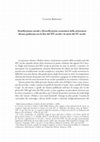
The issues with which the paper deals are:
1- the distribution of the dwellings of Jews in the ur... more The issues with which the paper deals are:
1- the distribution of the dwellings of Jews in the urban area of Padua,
2- the location of their business activities in the first decades of settlement in the city (the
second half of the XIVth century).
3- the process of overlapping among the Christian and Jewish élite.
From a methodological point of view, attention will be focused on the topographic location
of pawnshops; on recognition of areas where the largest number of clothing and used
items retailers were settled; and on Jewish real estate. Close attention will be given to data
concerning the average value of their real estate.
This set of information will be compared with data concerning the real estate of the Christian
élite in order to highlight the overlapping of the Jewish élite with the oldest Christian
economic élite.
The acquaintance with the Christian élite, indeed, took shape on several levels, indicating
regular association with, and incorporation and sharing of lifestyle.
It can, therefore, be assumed that the adaptation process of the Jewish elite to the Christian
one, to their styles and their habits (as it was described by Daniel Carpi in the XVIth century)
can be brought forward to the early decades of the XVth century.
Finally, in the paper not only the aspects regarding the élite are highlighted, but also the
economic, working and social conditions of the weaker strata of the minority Jewish
population in Padua.
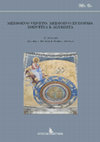
Knowledge and information about the Jewish presence in the Veneto area surrounded by Istria, Vero... more Knowledge and information about the Jewish presence in the Veneto area surrounded by Istria, Verona and the Venetian lagoon, are lacking. Notwithstanding, if information is contextualized within the broader framework of the great trade routes and communication, one is able to provide the frame of the movement of Jewish merchants in the Veneto region between 9th and 10th century. Treviso and Verona were probably stop-over of the trade caravans coming from the North and from the Balkans.
Relationships between Carolingian Empire and Jews, beside the protection and facilitation towards their commercial role, turned the “Marca of Treviso” into a preferential landing point before the final stage of the trip, which was accomplished travelling by sea. Such route should have begun in Venice, as it occurred before its protectionist turn or, hypothetically, by the portus Tarvisinus (the access to the sea of Treviso, place that today is known by the name of Mestre).
Things changed in the second half of 10th century, when Venice banned the conveyance of slaves and goods of Jews in the Venetian ships. Almost simultaneously took place in a significant way the initiative of expulsion of the Jews from Verona, symptom of a social and political context becoming more and more unfavorable to Jewish activities.

La vicenda degli Estensi è legata indissolubilmente alla storia dell'Europa medievale, per la vas... more La vicenda degli Estensi è legata indissolubilmente alla storia dell'Europa medievale, per la vastità dei possedimenti, l'ampiezza dei diritti e per i ruoli da loro ricoperti nella compagine dell'impero e del Regnum Italicum sulla scia del potere detenuto dai loro antenati, gli Obertenghi. Gli Obertenghi sono attestati come conti, marchesi e in seguito conti di palazzo tra la seconda metà del X e l'inizio dell'XI secolo, cariche che collocano il gruppo familiare nel ristretto ambito delle aristocrazie dominanti il continente nel primo medioevo. Lo stretto legame che univa i marchesi d'Este ad alcuni dei più importanti lignaggi del tempo (come ad esempio i Pallavicini, i marchesi di Massa e i Malaspina), anch'essi riconducibili al ceppo obertengo, è ulteriore elemento di distinzione della stirpe estense che, anche attraverso una fitta rete di rapporti di amicitia e parentela, riuscì a estendere la propria influenza e a occupare posizioni di primo piano nella partita per il potere. Obiettivo raggiunto grazie anche a un'accorta politica matrimoniale che gli Estensi attuarono in vista dei vantaggi derivanti dai vincoli con stirpi potenti e affermate sulla scena politica europea.
Death in Middle Ages was the subject of numerous representations: different images
with different... more Death in Middle Ages was the subject of numerous representations: different images
with different communicative purposes according to the period and milieu. I want to
focus attention on a single subject: two of the capitals from the lower porch of the
Palazzo Ducale [Doge’s Palace] in Venice. These capitals show the death of an old man
and the death of a young boy. What kind of representation of death are we examining
in relation to the historical period? Why does the artist, or artisan, represent death
here? What is the message communicated to the spectator and what is the function of
the representation in connection with the Palazzo Ducale? In that highly politicised
context, the answer to these questions can only be sought in the message itself that the
leaders of Venice wanted to convey to the world.
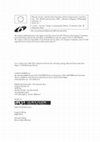
One source of interest in doing research on Leon Battista Alberti is to see how a man
of multiple... more One source of interest in doing research on Leon Battista Alberti is to see how a man
of multiple talents from the 15th-century elites viewed the world of work, including
craftsmanship and manual work in the broadest sense.
Numerous references to this broad canvas occur throughout Alberti’s output. Analysis
of such passages reveals too multi-faceted a mind to be reduced to one line of interpretation.
The author touches on subjects like discipline in learning, the importance of
practice and natural aptitude for work, but also on higher concepts like nature’s unattainable
perfection eluding the artist, or the basic distinction between art and crafts.
Craftsmanship and the mechanical arts emerge in an unusually noble light for the
times. Pursuing that line of thought, Alberti sees work as a means of social betterment
and personal improvement, thanks especially to the economic independence that only
professional know-how can ensure anyone lacking a source of unearned income.
The complex perspectives dealt with are the mirror of the author, torn as he was between
theory and application, between technical science and philosophy or letters.
Books by Claudia Bertazzo
The subject matter of this book is the phenomenon known as “anti-magnate legislation”. Such legis... more The subject matter of this book is the phenomenon known as “anti-magnate legislation”. Such legislation, or groups of laws implemented in several northern and central Italian cities in the 13th century, certainly constitutes a well-known and much
debated topic of Italian communal history.
I argue that the promulgation of this legislation should be considered part of a wide phase of “intensification”. Juridical pluralism and intensification of the law turn out to be the principal theoretical background of the legislation taken into consideration in this work.
These are juridical phenomena which are neither peculiar to the Middle Age, nor peculiar to the communal phase of the Italian history. Widening the perspective has allowed us to debunk the myth of the uniqueness of the legislation which for a long time has been defined “anti-magnate”.
Conference Presentations by Claudia Bertazzo
Convegno "La presenza ebraica nell'Italia nord-orientale
Circolazione di uomini, capitali e saper... more Convegno "La presenza ebraica nell'Italia nord-orientale
Circolazione di uomini, capitali e saperi tra Medio Evo
e prima Età Moderna"

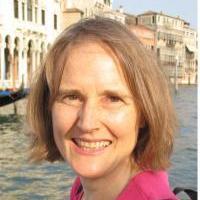








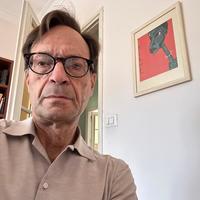
Uploads
Papers by Claudia Bertazzo
1- the distribution of the dwellings of Jews in the urban area of Padua,
2- the location of their business activities in the first decades of settlement in the city (the
second half of the XIVth century).
3- the process of overlapping among the Christian and Jewish élite.
From a methodological point of view, attention will be focused on the topographic location
of pawnshops; on recognition of areas where the largest number of clothing and used
items retailers were settled; and on Jewish real estate. Close attention will be given to data
concerning the average value of their real estate.
This set of information will be compared with data concerning the real estate of the Christian
élite in order to highlight the overlapping of the Jewish élite with the oldest Christian
economic élite.
The acquaintance with the Christian élite, indeed, took shape on several levels, indicating
regular association with, and incorporation and sharing of lifestyle.
It can, therefore, be assumed that the adaptation process of the Jewish elite to the Christian
one, to their styles and their habits (as it was described by Daniel Carpi in the XVIth century)
can be brought forward to the early decades of the XVth century.
Finally, in the paper not only the aspects regarding the élite are highlighted, but also the
economic, working and social conditions of the weaker strata of the minority Jewish
population in Padua.
Relationships between Carolingian Empire and Jews, beside the protection and facilitation towards their commercial role, turned the “Marca of Treviso” into a preferential landing point before the final stage of the trip, which was accomplished travelling by sea. Such route should have begun in Venice, as it occurred before its protectionist turn or, hypothetically, by the portus Tarvisinus (the access to the sea of Treviso, place that today is known by the name of Mestre).
Things changed in the second half of 10th century, when Venice banned the conveyance of slaves and goods of Jews in the Venetian ships. Almost simultaneously took place in a significant way the initiative of expulsion of the Jews from Verona, symptom of a social and political context becoming more and more unfavorable to Jewish activities.
with different communicative purposes according to the period and milieu. I want to
focus attention on a single subject: two of the capitals from the lower porch of the
Palazzo Ducale [Doge’s Palace] in Venice. These capitals show the death of an old man
and the death of a young boy. What kind of representation of death are we examining
in relation to the historical period? Why does the artist, or artisan, represent death
here? What is the message communicated to the spectator and what is the function of
the representation in connection with the Palazzo Ducale? In that highly politicised
context, the answer to these questions can only be sought in the message itself that the
leaders of Venice wanted to convey to the world.
of multiple talents from the 15th-century elites viewed the world of work, including
craftsmanship and manual work in the broadest sense.
Numerous references to this broad canvas occur throughout Alberti’s output. Analysis
of such passages reveals too multi-faceted a mind to be reduced to one line of interpretation.
The author touches on subjects like discipline in learning, the importance of
practice and natural aptitude for work, but also on higher concepts like nature’s unattainable
perfection eluding the artist, or the basic distinction between art and crafts.
Craftsmanship and the mechanical arts emerge in an unusually noble light for the
times. Pursuing that line of thought, Alberti sees work as a means of social betterment
and personal improvement, thanks especially to the economic independence that only
professional know-how can ensure anyone lacking a source of unearned income.
The complex perspectives dealt with are the mirror of the author, torn as he was between
theory and application, between technical science and philosophy or letters.
Books by Claudia Bertazzo
debated topic of Italian communal history.
I argue that the promulgation of this legislation should be considered part of a wide phase of “intensification”. Juridical pluralism and intensification of the law turn out to be the principal theoretical background of the legislation taken into consideration in this work.
These are juridical phenomena which are neither peculiar to the Middle Age, nor peculiar to the communal phase of the Italian history. Widening the perspective has allowed us to debunk the myth of the uniqueness of the legislation which for a long time has been defined “anti-magnate”.
Conference Presentations by Claudia Bertazzo
Circolazione di uomini, capitali e saperi tra Medio Evo
e prima Età Moderna"
1- the distribution of the dwellings of Jews in the urban area of Padua,
2- the location of their business activities in the first decades of settlement in the city (the
second half of the XIVth century).
3- the process of overlapping among the Christian and Jewish élite.
From a methodological point of view, attention will be focused on the topographic location
of pawnshops; on recognition of areas where the largest number of clothing and used
items retailers were settled; and on Jewish real estate. Close attention will be given to data
concerning the average value of their real estate.
This set of information will be compared with data concerning the real estate of the Christian
élite in order to highlight the overlapping of the Jewish élite with the oldest Christian
economic élite.
The acquaintance with the Christian élite, indeed, took shape on several levels, indicating
regular association with, and incorporation and sharing of lifestyle.
It can, therefore, be assumed that the adaptation process of the Jewish elite to the Christian
one, to their styles and their habits (as it was described by Daniel Carpi in the XVIth century)
can be brought forward to the early decades of the XVth century.
Finally, in the paper not only the aspects regarding the élite are highlighted, but also the
economic, working and social conditions of the weaker strata of the minority Jewish
population in Padua.
Relationships between Carolingian Empire and Jews, beside the protection and facilitation towards their commercial role, turned the “Marca of Treviso” into a preferential landing point before the final stage of the trip, which was accomplished travelling by sea. Such route should have begun in Venice, as it occurred before its protectionist turn or, hypothetically, by the portus Tarvisinus (the access to the sea of Treviso, place that today is known by the name of Mestre).
Things changed in the second half of 10th century, when Venice banned the conveyance of slaves and goods of Jews in the Venetian ships. Almost simultaneously took place in a significant way the initiative of expulsion of the Jews from Verona, symptom of a social and political context becoming more and more unfavorable to Jewish activities.
with different communicative purposes according to the period and milieu. I want to
focus attention on a single subject: two of the capitals from the lower porch of the
Palazzo Ducale [Doge’s Palace] in Venice. These capitals show the death of an old man
and the death of a young boy. What kind of representation of death are we examining
in relation to the historical period? Why does the artist, or artisan, represent death
here? What is the message communicated to the spectator and what is the function of
the representation in connection with the Palazzo Ducale? In that highly politicised
context, the answer to these questions can only be sought in the message itself that the
leaders of Venice wanted to convey to the world.
of multiple talents from the 15th-century elites viewed the world of work, including
craftsmanship and manual work in the broadest sense.
Numerous references to this broad canvas occur throughout Alberti’s output. Analysis
of such passages reveals too multi-faceted a mind to be reduced to one line of interpretation.
The author touches on subjects like discipline in learning, the importance of
practice and natural aptitude for work, but also on higher concepts like nature’s unattainable
perfection eluding the artist, or the basic distinction between art and crafts.
Craftsmanship and the mechanical arts emerge in an unusually noble light for the
times. Pursuing that line of thought, Alberti sees work as a means of social betterment
and personal improvement, thanks especially to the economic independence that only
professional know-how can ensure anyone lacking a source of unearned income.
The complex perspectives dealt with are the mirror of the author, torn as he was between
theory and application, between technical science and philosophy or letters.
debated topic of Italian communal history.
I argue that the promulgation of this legislation should be considered part of a wide phase of “intensification”. Juridical pluralism and intensification of the law turn out to be the principal theoretical background of the legislation taken into consideration in this work.
These are juridical phenomena which are neither peculiar to the Middle Age, nor peculiar to the communal phase of the Italian history. Widening the perspective has allowed us to debunk the myth of the uniqueness of the legislation which for a long time has been defined “anti-magnate”.
Circolazione di uomini, capitali e saperi tra Medio Evo
e prima Età Moderna"